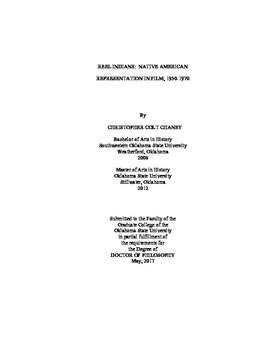| dc.contributor.advisor | Moses, L. G. | |
| dc.contributor.author | Chaney, Christopher Colt | |
| dc.date.accessioned | 2018-03-13T18:15:10Z | |
| dc.date.available | 2018-03-13T18:15:10Z | |
| dc.date.issued | 2017-05 | |
| dc.identifier.uri | https://hdl.handle.net/11244/54501 | |
| dc.description.abstract | The perception of Native Americans has constantly been in flux since Europeans began to colonize North America. Whether it was the Spanish, British, or later the Americans, each had a vision for what Indians were and could be. As popular culture mediums have changed, so have perceptions. From dime novels to Wild West Shows to big budget Hollywood films, Indians and frontier stories have received top billing. However, westerns have not always been accurate in their portrayal of Indians. Indian activists have been trying to get their voices heard and affect changes in the film industry since the early days of filmmaking. There has been lot of research describing the failures of filmmakers in representing native cultures; nevertheless, not all have been negative. Starting in 1950, before the peak of the civil rights movement and while westerns were still popular, some in Hollywood were making westerns that attempted to show Native Americans as real three-dimensional people and not caricatures of a forgotten time. Throughout the 1950s, there were westerns that began to focus on Indian stories or put Indians at the forefront of the film. By 1960, the western genre was waning in popularity. With the counter culture movement and a shift in the political climate, it is understandable that frontier stories were becoming outdated. The anti-war and satirical western are the most memorable involving Indians, from 1970, closing the tumultuous 1960s. Modern Native American filmmakers are finally seeing the changes for which the previous generations fought. These modern artists are able to tell their own stories and represent what they deem important to a larger audience. By studying the politics, activists, and films from 1950-1970 it is possible to tie in historical events from the frontier and examine what people from the era thought about the American West and Indians. | |
| dc.format | application/pdf | |
| dc.language | en_US | |
| dc.rights | Copyright is held by the author who has granted the Oklahoma State University Library the non-exclusive right to share this material in its institutional repository. Contact Digital Library Services at lib-dls@okstate.edu or 405-744-9161 for the permission policy on the use, reproduction or distribution of this material. | |
| dc.title | Reel Indians: Native American representation in film, 1950-1970 | |
| dc.contributor.committeeMember | Bryans, William | |
| dc.contributor.committeeMember | Logan, Michael | |
| dc.contributor.committeeMember | Perkins, Stephen | |
| osu.filename | Chaney_okstate_0664D_15077.pdf | |
| osu.accesstype | Open Access | |
| dc.type.genre | Dissertation | |
| dc.type.material | Text | |
| thesis.degree.discipline | History | |
| thesis.degree.grantor | Oklahoma State University | |
